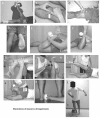Reliability of measures of impairments associated with patellofemoral pain syndrome
- PMID: 16579850
- PMCID: PMC1557500
- DOI: 10.1186/1471-2474-7-33
Reliability of measures of impairments associated with patellofemoral pain syndrome
Abstract
Background: The reliability and measurement error of several impairment measures used during the clinical examination of patients with patellofemoral pain syndrome (PFPS) has not been established. The purpose was to determine the inter-tester reliability and measurement error of measures of impairments associated with PFPS in patients with PFPS.
Methods: A single group repeated measures design was used. Two pairs of physical therapists participated in data collection. Examiners were blinded to each others' measurements.
Results: Thirty patients (age 29 +/- 8; 17 female) with PFPS participated in this study. Inter-tester reliability coefficients were substantial for measures of hamstrings, quadriceps, plantarflexors, and ITB/TFL complex length, hip abductors strength, and foot pronation (ICCs from .85 to .97); moderate for measures of Q-angle, tibial torsion, hip external rotation strength, lateral retinacular tightness, and quality of movement during a step down task (ICCs from .67 to .79); and poor for femoral anteversion (ICC of .45). Standard error of measurement (SEM) for measures of muscle length ranged from 1.6 degrees to 4.3 degrees. SEM for Q-angle, tibial torsion, and femoral anteversion were 2.4 degrees, 2.9 degrees, and 4.5 degrees respectively. SEM for foot pronation was 1 mm. SEM for measures of muscle strength was 1.8 Kg for abduction and 2.4 Kg for external rotation.
Conclusion: Several of the impairments associated with PFPS had sufficient reliability and low measurement error. Further investigation is needed to test if these impairment measurements are related to physical function and whether or not they are useful for decision-making.
Figures

References
-
- Brody LT, Thein JM. Nonoperative treatment for patellofemoral pain. J Orthop Sports Phys Ther. 1998;28:336–344. - PubMed
-
- Dehaven KE, Dolan WA, Mayer PJ. Chondromalacia patellae in athletes. Clinical presentation and conservative management. Am J Sports Med. 1979;7:5–11. - PubMed
-
- Rubin B, Collins R. Runner's knee. Phys Sportsmed. 1980;8:49–58. - PubMed
-
- Grabiner MD, Koh TJ, Draganich LF. Neuromechanics of the patellofemoral joint. Med Sci Sports Exerc. 1994;26:10–21. - PubMed
-
- Sikorski JM. Importance of femoral rotation in chondromalacia patellae as shown by serial radiography. J Bone Joint Surg(Br) 1979;61:435–442. - PubMed
Publication types
MeSH terms
LinkOut - more resources
Full Text Sources
Medical

